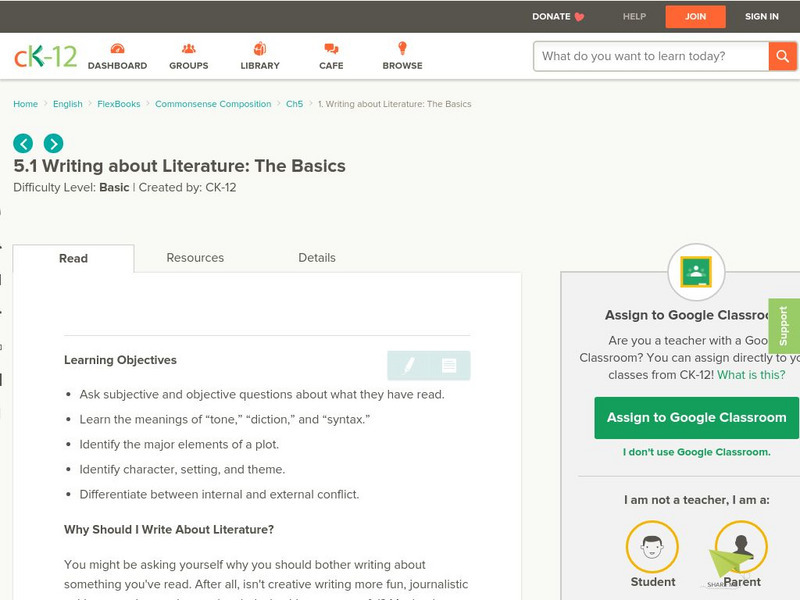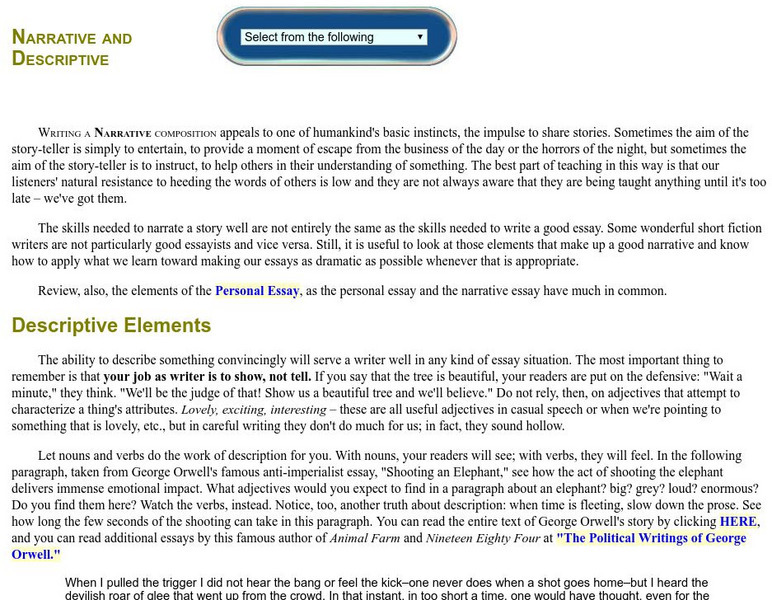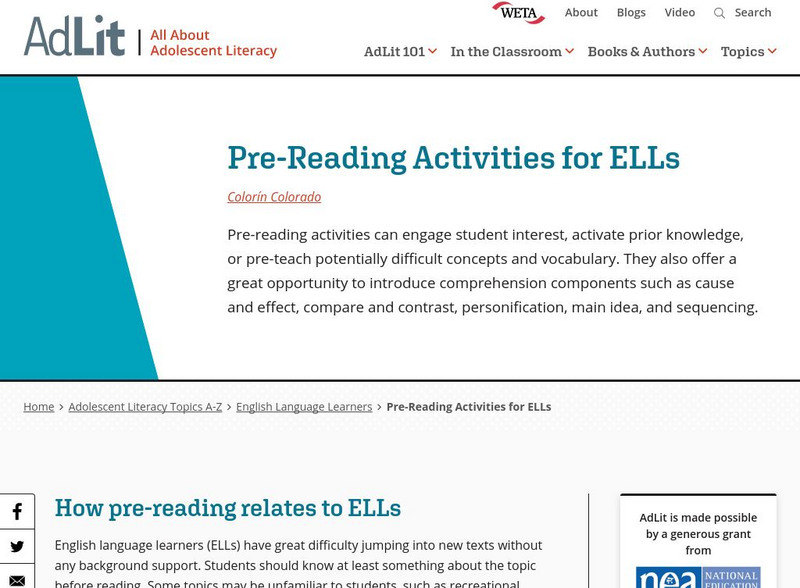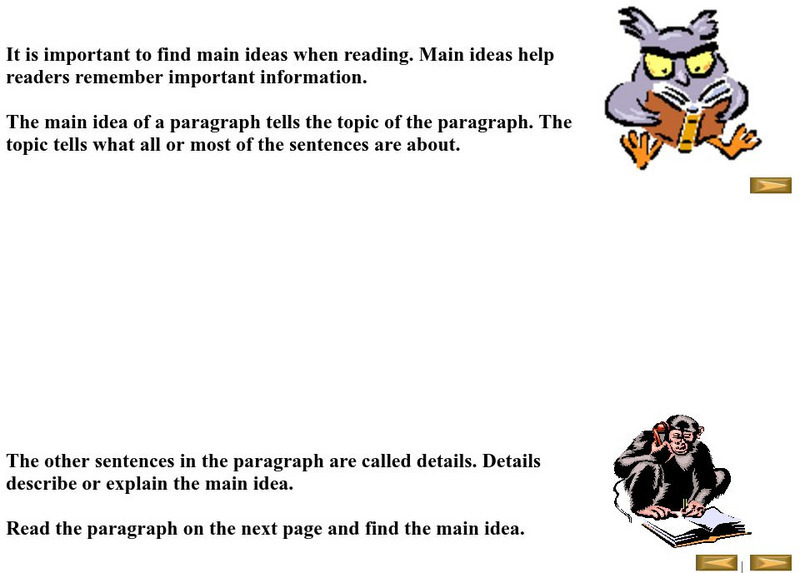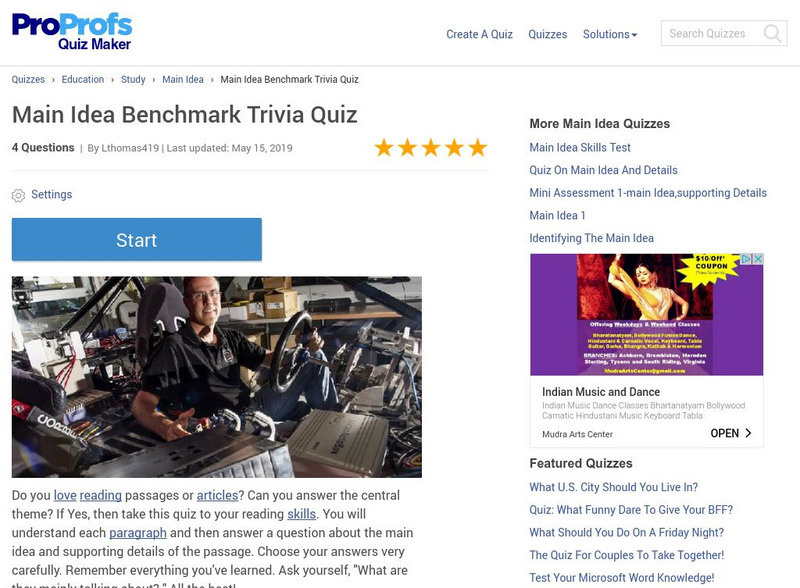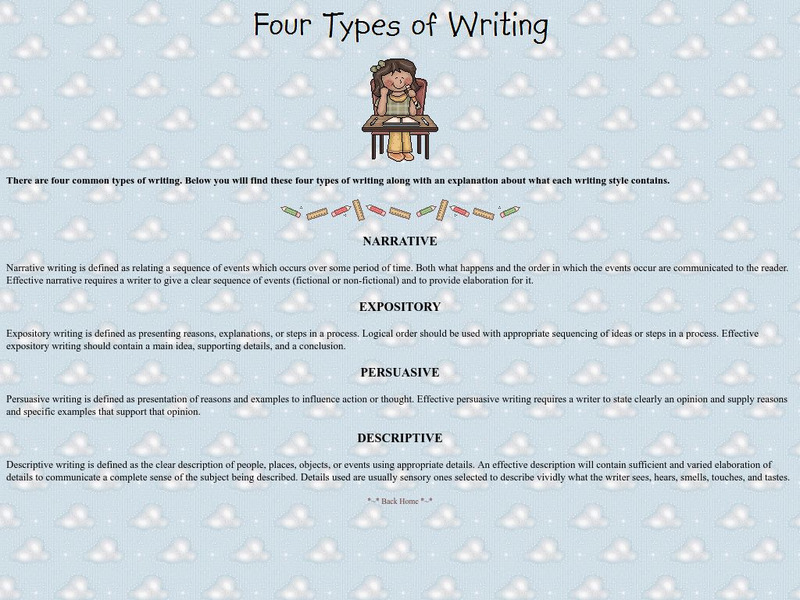Other
Sas: Exploring Ways Authors Use Text Structures to Convey Meaning
In this activity, students will explore ways authors use text structures to convey meaning through cause and effect, sequencing, comparison, and more.
Better Lesson
Better Lesson: What the Heck Is That? Inferring the Purpose of an Object
In this lesson, 5th graders use their prior knowledge and inference skills to determine uses of unfamiliar objects. They participate in group discussions and analyze the key information they have in order to reach conclusions.
ArtsNow
Arts Now Learning: Personal Storytelling With Accordion Books [Pdf]
In this lesson, students use the structure of an accordion book to identify parts of an essay: introduction, three supporting details, and conclusion. They then compose a personal story using events from the past school year and plan the...
E Reading Worksheets
E Reading Worksheets: Writing Narrative Essays
This article provides the components of narrative writing. The author emphasizes ways to make narrative writing better. W.9-10.3e Conclusion
CK-12 Foundation
Ck 12: 5.1 Writing About Literature: The Basics
[Free Registration/Login may be required to access all resource tools.] Learn the basics of how to write about literature by asking subjective and objective questions; use tone, diction, and syntax; identify plot elements, and...
CK-12 Foundation
Ck 12: 2.1: Narrative Essay
[Free Registration/Login may be required to access all resource tools.] Learn to write a narrative essay by identifying the differences between descriptive and narrative essays, knowing the difference between autobiographical and...
Florida Center for Reading Research
Florida Center for Reading Research: Check a Trait
A lesson plan in which learners read a narrative text and complete a graphic organizer to describe the characters in the story. Materials are included. [PDF]
Alabama Learning Exchange
Alex: Better Living Through Science
This lesson involves research on scientists whose accomplishments have impacted areas of nutrition, sanitation, or health care. Students will research an area of their choice, record information on a graphic organizer, and use the...
Alabama Learning Exchange
Alex: Savvy Story Structure
During this lesson, young scholars learn to actively engage in reading by becoming more familiar with the elements of a story. Students will be required to think at a higher level and will enhance their understanding of selected passages...
Alabama Learning Exchange
Alex: Powerful Book Reports
This lesson allows students to identify the critical components of a story while developing expertise in creating and presenting multimedia presentations.
PBS
Pbs Learning Media: Recurring Themes the Lives of Nanavi and Neeraj
Students practice identifying themes using questions from varying perspectives (their own, the author's, and the main character's).
South Carolina Educational Television
Know It All: Summarizing Texts
Fifth graders will review what a summary is and complete a worksheet for practice. They will then write their own informational text and a peer will summarize.
South Carolina Educational Television
Know It All: Types of Conflict
Students will learn about the four major types of conflict. They will use children's books to identify the types of conflict used, as well as create their own narratives using one of the types of conflict.
South Carolina Educational Television
Know It All: Non Fiction Text Features
Fifth graders will use non-fiction books to identify and explain how text features help them as individual readers.
Louisiana Department of Education
Louisiana Doe: Louisiana Believes: Guide for Determining Text Complexity
An educator's guide to help determine the level of text complexity.
Capital Community College Foundation
Guide to Grammar and Writing: The Narrative Essay
Need help picking out the elements of a narrative? Check this site out from Capital Community College, and you'll see some background information, a sample essay, and directed questions to ask yourself about a text. W.9-10.3 Narrative,...
AdLit
Ad lit.org: Classroom Strategies: Story Maps
Story Maps are used for teaching students to work with story structure for better comprehension. This technique uses visual representations to help students organize important elements of a story. Students learn to summarize the main...
AdLit
Ad lit.org: Pre Reading Activities for El Ls
Pre-reading activities can engage student interest, activate prior knowledge, or pre-teach potentially difficult concepts and vocabulary. They also offer a great opportunity to introduce comprehension components such as cause and effect,...
SMART Technologies
Smart: Reviewing Sequence of Events
Students will identify time-order words in order to comprehend passages, place events in sequential order on a time line, and use a flow chart to organize their thoughts for writing in this interactive SMART whiteboard activity.
Beacon Learning Center
Beacon Learning Center: Web Lessons: Get the Main Idea
This resource provides practice finding the main idea by having students read a paragraph and choose the main idea. Then it asks students to take what they have learned and apply it to a book of their choice, and then write a paragraph...
Polk Brothers Foundation Center for Urban Education at DePaul University
Depaul University: Center for Urban Education: Compare and Contrast [Pdf]
This graphic organizer includes a Venn Diagram. Students will then answer a guiding question to synthesize the information on the Venn Diagram.
Polk Brothers Foundation Center for Urban Education at DePaul University
Depaul University: Center for Urban Education: Compara Y Contrasta [Pdf]
Students will compare and contrast information with the aid of this Venn Diagram that has been translated into Spanish. Students will answer a guiding question to help them summarize the content of the diagram.
ProProfs
Pro Profs: Main Idea Benchmark
This is a four-question multiple choice quiz over the main idea; students read nonfiction passages and select the main idea. Links to related quizzes on the same topic are provided.
Other
Sanchezclass.com: Four Types of Writing
Definitions of the four types of writing: narrative, expository, persuasive, and descriptive.


![Arts Now Learning: Personal Storytelling With Accordion Books [Pdf] Lesson Plan Arts Now Learning: Personal Storytelling With Accordion Books [Pdf] Lesson Plan](https://static.lp.lexp.cloud/images/attachment_defaults/resource/large/FPO-knovation.png)
